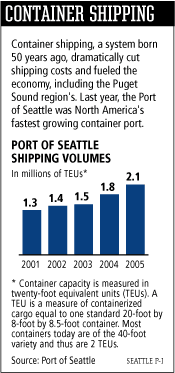forum
library
tutorial
contact

Containerization Changed Shipping Industry Forever
by George Raine, San Francisco ChronicleSeattle Post-Intelligencer, February 10, 2006
|
the film forum library tutorial contact |

|
Containerization Changed Shipping Industry Foreverby George Raine, San Francisco ChronicleSeattle Post-Intelligencer, February 10, 2006 |
Globalization is having an anniversary.
It was 50 years ago that Malcom McLean, an entrepreneur from North Carolina, loaded a ship with 58 35-foot containers and sailed from Newark, N.J., to Houston.
 He wasn't the only one to suggest that containers might make shipping more efficient. But he was the first to design a transportation system around the packaging of cargo in huge metal boxes that could be loaded and unloaded by cranes.
He wasn't the only one to suggest that containers might make shipping more efficient. But he was the first to design a transportation system around the packaging of cargo in huge metal boxes that could be loaded and unloaded by cranes.
Container shipping eventually replaced the traditional "break-bulk" method of handling crates, barrels and bags, and stowing them loose in a ship's hold, a system in use since the days of the Phoenicians.
Replacing break-bulk with cargo containers dramatically reduced shipping costs, reinvigorating markets and fueling the world economy -- as well as the Puget Sound region's.
The Port of Seattle was North America's fastest-growing container port in 2005 with a record 2.088 million 20-foot equivalent units, which is the measure of a standard container used to determine container capacity. That was an increase of 17.6 percent from the previous year, according to port figures.
Also coming up is the Port of Tacoma, which also had a record haul last year with 2.07 million 20-foot equivalent units, up 15 percent over its previous year, according to the port's figures.
McLean, who died in 2001 at 87, shares the credit with Matson Navigation Co. of San Francisco, a longtime force in Pacific shipping. Two years after McLean loaded his ship, the Ideal-X, Matson's Hawaiian Merchant inaugurated container shipping in the Pacific, carrying 20 24-foot-long cargo holders from Alameda, Calif., to Honolulu.
The world took note of McLean's Sea-Land operation in the Atlantic and Matson in the Pacific, and containerization began to take hold.
In 1959, according to Matson research, the industry was loading and unloading 0.627 tons per man hour. By 1976, with container shipping well established, the figure was 4,234 tons per man hour. A ship's time in port shrank from three weeks to 18 hours.
In 1950, an average commercial vessel could carry 10,000 tons at a speed of 16 knots. With container shipping, the average commercial vessel carried 40,000 tons at a speed of 23 knots, Matson says.
The numbers are larger today. A vessel capable of carrying 6,600 20-foot containers can carry 77,000 tons at up to 24.8 knots.
"Containerization has transformed global trade in manufactured goods as dramatically as jet planes have changed the way we travel and the Internet has changed the way we communicate," said Joseph Bonney, editor of the Journal of Commerce, the bible of the shipping industry. "The Asian economic miracle of the last two decades could not have happened without the efficient transportation that containerized shipping provides."
Two books are to be published in April around the anniversary of McLean's sailing. One, by Bonney of the Journal of Commerce and Arthur Donovan, a maritime historian, is called "The Box That Changed the World." The other is by economist Marc Levinson, titled "The Box: How the Shipping Container Made the World Smaller and the World Economy Bigger." They describe the sweeping change to a world of lower shipping costs.
Both tell the story of McLean, who began his McLean Trucking Co. in North Carolina with a single vehicle in March 1934 and went on to make a fortune. He told people that the container-shipping concept came to him early in his career when he had to cool his heels at Hoboken, N.J., waiting his turn to load bales of cotton on a ship. He realized it would save time and money if he could simply load his trailer onto a ship. He decided to get into the shipping business.
To comply with regulatory requirements, McLean had to sell his trucking company before acquiring Pan-Atlantic Steamship Corp. in the mid-1950s, which he bought for its coastal shipping rights, according to Bonney. He then bought two World War II tankers -- including the Ideal-X, built in 1945 and used to launch the container venture in 1956. He began carrying containers on the East Coast.
Pan-Atlantic became Sea-Land Service in 1960. Its international services were sold to Maersk in 1999 and the combined company was named Maersk Sealand. The former Sea-Land's domestic services in Hawaii, Guam, Alaska and Puerto Rico now operate as Horizon Lines.
Matson, long based in San Francisco but now in Oakland, Calif., as early as 1954 was seeking improvements in cargo transportation and distribution.
Its solution was a lift-on, lift-off program in which a gantry crane hoists containers, replacing the use of a wheeled chassis to transport loose cargo on and off vessels.
"Of the many milestones in Matson's 124-year history, containerization is clearly one of the company's most significant achievements," said James Andrasick, its president and chief executive.
With world trade booming, cargo from Asia is expected to double at the major West Coast ports by 2020, according to the Pacific Maritime Association.
Cheap shipping, fueled by containerization, is remaking the world.
learn more on topics covered in the film
see the video
read the script
learn the songs
discussion forum
